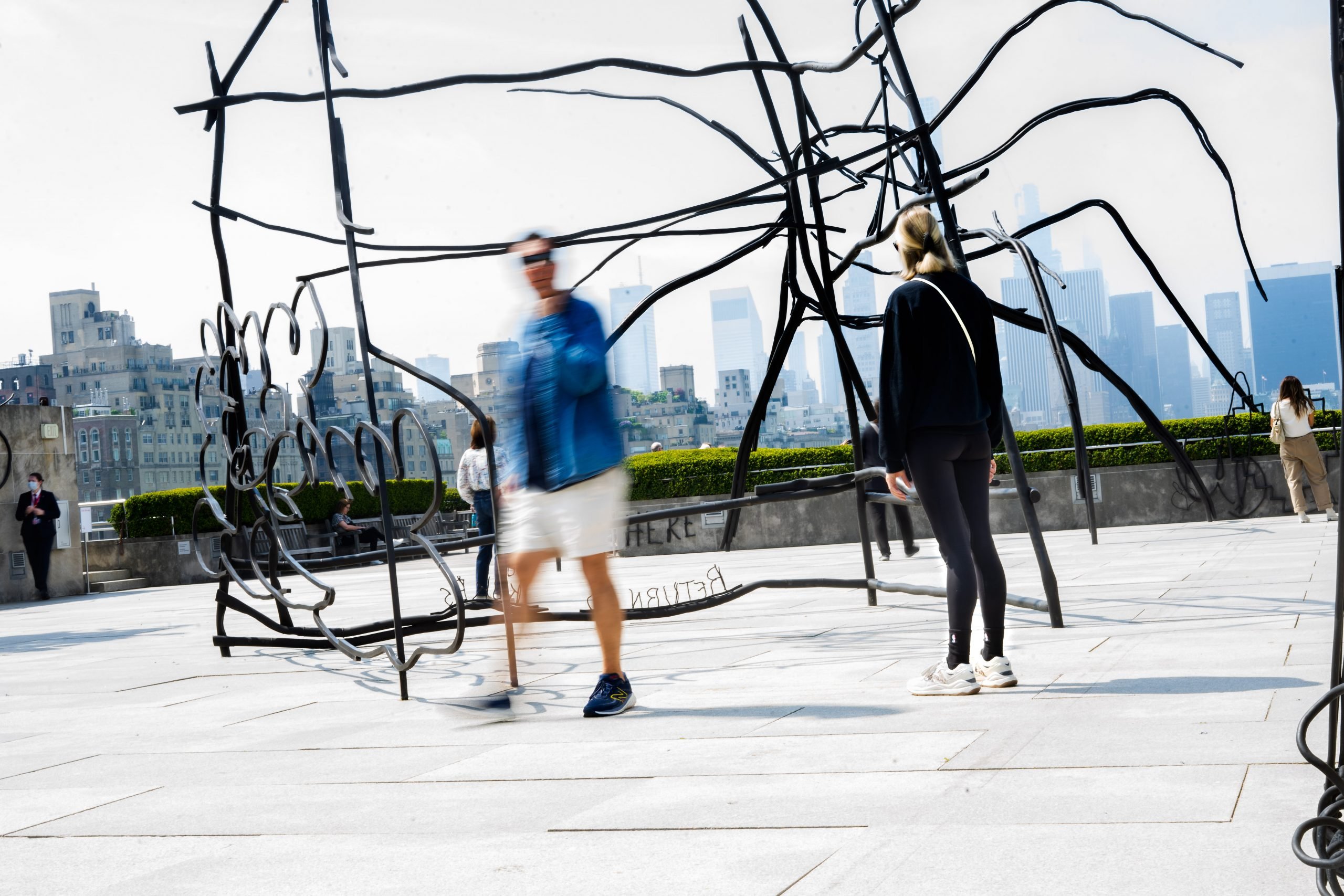
Petrit Halilaj, a Kosovar artist born in the former Yugoslavia, has unveiled a major installation in the roof garden of the Metropolitan Museum of Art in New York City inspired by his childhood in the Balkan country. The installation, Abetare (2024), borrows its name from the book Halilaj and his peers used to learn the alphabet in school. The work—his first major piece in the United States—was conceived by the artist in consultation with curator Iria Candela.
Petrit Halilaj, Abetare (2024) on view at the roof garden of the Metropolitan Museum of Art in New York City. Photo by Adam Schrader.
Halilaj was raised in the small Kosovar village of Runik before he was displaced by the Kosovo War in the late 1990s as Serbians sought to expel ethnic Albanians from the land. At 13 years old, he was sent to a refugee camp called Kukës where his family survived the war. The phrase “Return to Kukës” appears in part of the installation.
The artist, now based in Berlin, was inspired by the doodles of children he saw on desks while visiting his former school in Runik, which, in 2012, was in the process of being demolished after surviving the war. “We are a very small village, and that school was one of the few architectural landmarks that survived the war,” Halilaj recalled during a press preview on April 29.
Petrit Halilaj, Abetare (2024) on view at the roof garden of the Metropolitan Museum of Art in New York City. Photo by Adam Schrader.
Halilaj said he didn’t understand why the town was happy to tear it down and build a new school, even if it came with fewer “holes and traces of war.” But while on a quick stop to take a picture for posterity, he saw a band of kids playing in the school’s garden. The children pointed him to desks that had been thrown out—to look at drawings on them.
“These desks were from the ‘70s, years I was not yet born. They have seen the fall of Yugoslavia, all the conflicts of the ‘90s, all the segregation, all the war. They still survived. All those generations of kids were all coexisting in a very beautiful mix with each other,” he said.
Petrit Halilaj, Abetare (2024) on view at the roof garden of the Metropolitan Museum of Art in New York City. Photo by Adam Schrader.
He said he loved seeing the symbols of United Nations peacekeepers juxtaposed with the name of the Argentinian soccer star Lionel Messi. He called the drawings “moments of freedom and expression” for the children who made them.
In his work, Halilaj has rendered details in the sculptures that include the famous “Super S” that children often draw in their notebooks, as well as a rendering of Batman, a penis, the word “tiddies,” and the phrase “2+2=5”—a symbol of dystopian groupthink from George Orwell’s 1984.
Detail of Petrit Halilaj, Abetare (2024) on view at the roof garden of the Metropolitan Museum of Art in New York City. Photo by Adam Schrader.
The works also have references to pop culture, including flowers inspired by those painted by Andy Warhol and references to fellow creative Dua Lipa, the Albanian singer who lived in Pristina with her family after Kosovo declared independence in 2008.
Candela said Halilaj also spent time visiting other schools across the Balkans for research—photographing children’s desks and creating an inventory of the drawings on them. “He organized them by subject, like hearts or sexual elements or reference to history or houses, and he made a huge catalogue of them across the Balkan region,” she said.
Iria Candela in front of sculptures by Kosovar artist Petrit Halilaj installed in the roof garden of the Metropolitan Museum of Art in New York City. Photo by Adam Schrader.
In the studio, he decided which drawings he would select and enlarged them to scale then worked with a scale model of the Met’s rooftop garden to orchestrate the placement of the installation’s elements. Candela said all the drawings come directly from the sources they were taken from and that Halilaj did not add or change their designs other than transforming their material and enlarging them.
“The large spider has a couple of legs out of the planters, so you don’t know if the spider is trying to escape or it’s coming in from the park,” Candela said. She emphasized that she also enjoyed the contrast of the dark contours of the sculpture against the white sky of the foggy day of the interview.
Abetare, she added, follows another outdoor commission in Pristina, the capital of Kosovo, in which Halilaj installed five stars on the rooftop of a former five-star hotel—now abandoned—that was used as a prison and torture chamber by Serbian forces who took over it when they invaded Kosovo.
Petrit Halilaj, Abetare (2024) on view at the roof garden of the Metropolitan Museum of Art in New York City. Photo by Adam Schrader.
“Petrit is, among our Met staff, our most favorite and beloved artist and he won all competitions of who we want to work with,” Max Hollein, the CEO and director of the Met, said as the installation was unveiled. “We love the excitement, the energy, the imagination, and artistic ambition. Petrit’s work is also of course deeply rooted in areas the museum engages with in many way—history, homeland, and migration.”